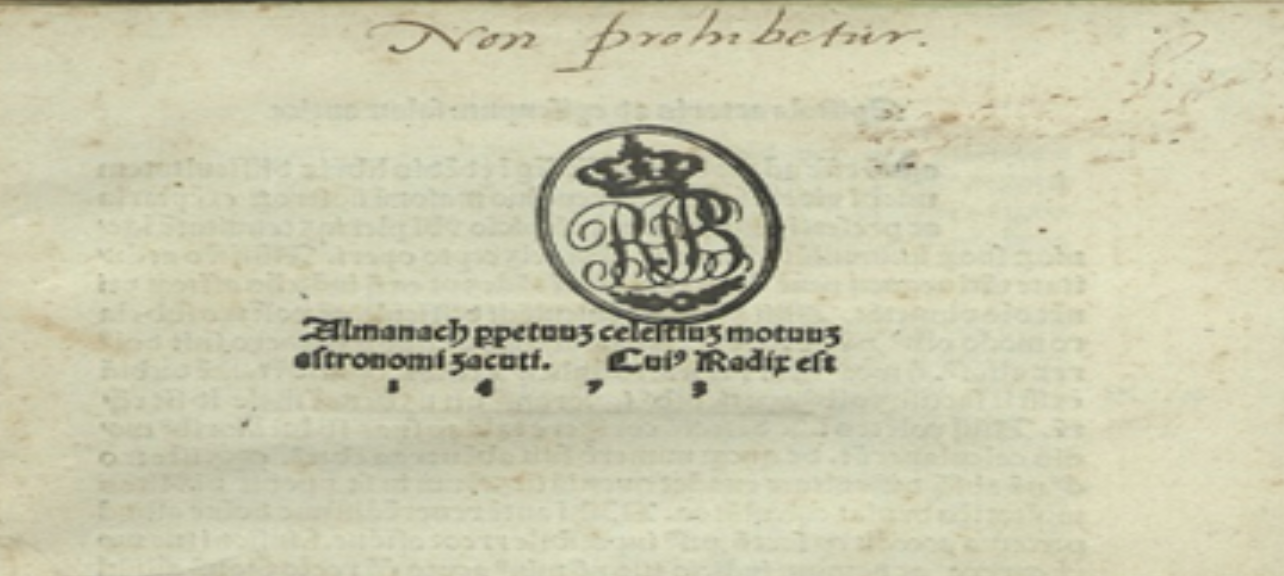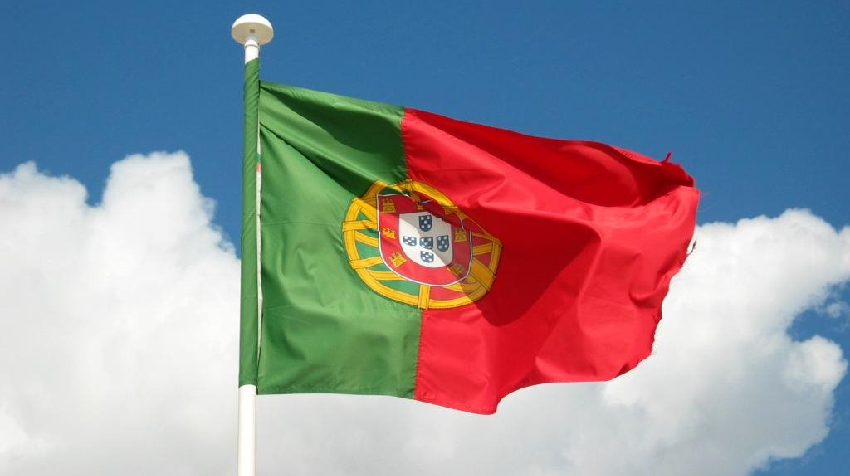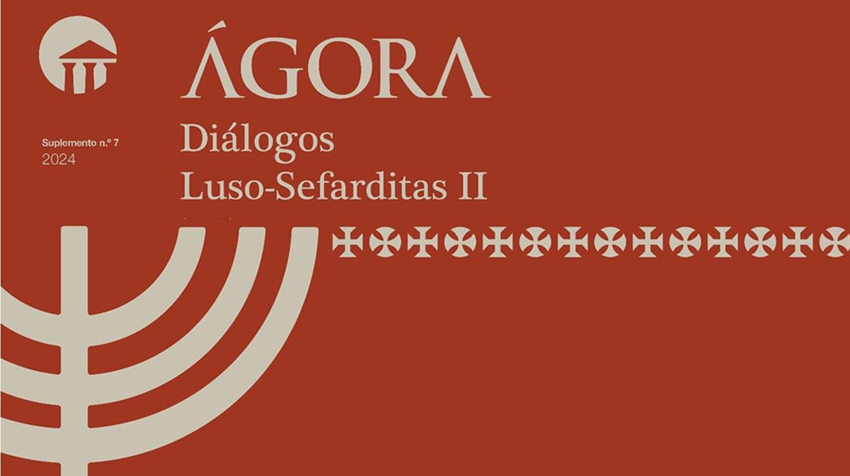The Almanach Perpetuum. Printed in Leiria, 1496. In the Portuguese National Library, Lisbon.
On February 25, 1496, in the printing shop of the D’Ortas family in Leiria, Portugal, the first ever printing of the Almanach Perpetuum, was completed. This was the last book printed in a Hebrew printing shop in the Iberian Peninsula. It was the only incunabula printed in an Iberian Hebrew printing shop in a language other than Hebrew. It was the first scientific book printed in Portugal. It was by far the most influential Portuguese incunabula in any language or any genre. On December 5, 1496, a mere ten months later, the Portuguese monarch D. Manuel I decreed the expulsion of all Jews from Portugal - the native community plus a massive number of Spanish Jewish refugees in the aftermath of the Expulsion in 1492. This effectively triggered the immediate confiscation of Jewish ritual objects and Hebrew books and the systematic dismantling of Jewish institutions. Organized Jewish life in the Iberian Peninsula would soon cease to exist.
The Almanach Perpetuum is a rendition, with versions in both Latin and Spanish, of Chibbur HaGadol, the Hebrew language mathematics and astronomy masterpiece of R. Abraham Zacuto (1452–c. 1515), written in Salamanca, Spain, between 1473 and 1478. The bulk of the book is a set of astronomical tables providing information necessary to perform various types of astronomical calculations. R. Zacuto, who himself fled to Portugal in 1492, is identified in the colophon as the “astronomer of the highly serene King Manuel, King of Portugal”. The original text in Hebrew was translated into Latin and then into Spanish by Master José Vizinho, a Jewish mathematician, astronomer and medical doctor, who the colophon identifies as a disciple of R. Zacuto.
First page of the Almanach Perpetuum. Printed in Leiria, 1496. In the Portuguese National Library, Lisbon.
The Almanach Perpetuum addresses a key scientific issue created by the geopolitical situation at the time. The conquest of Constantinople by the Ottoman Empire in 1453 disrupted the European land trade routes with Asia. As such, the quest for alternative maritime routes was of the greatest strategic importance. Yet, the limitations of the existing navigation techniques, which were designed for sailing along the coast or along known routes, and were based on polar observations, placed serious limitations. They did not work for high seas navigation, or for unknown routes, or in places close to the equator where polar observations were not possible, all characteristics of the new maritime voyages. R. Zacuto’s work revolutionized ocean navigation by providing in this work the first tables allowing the use of the position of the sun for location guidance. At the same time, and given the obvious difficulties in measuring the position of the sun by direct observation, R. Zacuto developed a new metal nautical astrolabe to generate indirect measurements.
The Almanach Perpetuum and the new astrolabe constituted the global positioning system of the Iberian navigators. In Spain, Christopher Columbus from his 1492 voyage on used these tables extensively. Master Vizinho had brought them to his attention when he visited Lisbon a few years prior. A personal copy of the tables belonging to Columbus with his handwritten notes is extant in the Colombiana Library in Seville, Spain. In Portugal, the tables and astrolabe were extensively used by the navigators, first in experimental exploits often under the direct guidance of Master Vizinho, and then, after 1497, directly by Vasco da Gama. Until the middle 1500s, these tables were the basic resource for location guidance when sailing to the Americas or to India.
Page with colophon of Almanach Perpetuum. Printed in Leiria, 1496. In the Portuguese National Library, Lisbon.
The case of the printing of the Almanach Perpetuum in February of 1496 - edited by a Jew, based on the scientific work of another Jew, and printed by yet another Jew - epitomizes the policy dilemmas facing D. Manuel I and the corresponding dark clouds hovering over the Portuguese Jewish community. In July of 1497, Vasco da Gama left with his fleet to discover the maritime route to India taking with him R. Zacuto’s charts and instruments. D. Manuel I had been for the last few years in the middle of difficult negotiations to promote the union of the Iberian crowns through his marriage to one of the daughters of Ferdinando and Isabella of Spain. He knew that the price the Catholic Monarchs demanded was the expulsion of the Jews from Portugal. He also knew that expelling the Jews would mean a financial, scientific, and logistic disaster that would compromise maritime expansion and the development of new trade routes. So, D. Manuel I faced a dilemma: he needed to get rid of the Jews while at the same time he needed to keep them. The solution? In December of 1496, a mere nine months after the printing, he decreed the expulsion of all Jews. By October of 1497, a mere sixteen months after the printing, expulsion had fully morphed into forced conversions and the prohibition from leaving Portugal. The Jewish Community would cease to exist. The Jews, themselves, would have to remain, but now as New-Christians.
Manuel II (1889-1932), the last king of Portugal having been deposed in 1910, was an avid bibliophile and a keen student of the events of the reign of his namesake D. Manuel I. He owned a very rare complete copy of the Spanish language version of the Almanach Perpetuum printed in 1496 in Leiria. In the late 1920s, D. Manuel II wrote an article in The American Hebrew of New York City with the title “A Victim of Royal Ingratitude”. In this article, he states that R. Zacuto “who paved the way for Portugal to achieve the zenith of its glory, was expelled by the two sovereigns he so well served” and, therefore, was a victim of “a great and burning ingratitude”. We must recognize that such sentiments should be extended to Master Vizinho and his family, to the D’Ortas and his family, to the countless families of Jewish artisans, merchants, physicians … and to the myriads of anonymous Jewish families who at the time called Portugal home and so much contributed to its history.
NOTE: This text is based on chapter 5 of my new book with R. Eli Rosenfeld, of Chabad of Portugal titled “Monuments of Paper and Parchment: The History of Hebrew Printing in Portugal” forthcoming in 2023. This is the third book in the bilingual [English and Portuguese] series ‘From the Mists of Memory” published by Chabad Portugal Press and focusing on bringing to the limelight the lives and contributions of Jewish leaders and scholars in the pre-1497 period in Portugal. The first book, “Jewish Voices from Portugal”, published in 2018, presents commentaries on the Torah portions based on the writings of six rabbis who then lived in Portugal. The second, “Jewish Ethics from Portugal”, published in 2021 does the same for commentaries on Pirkei Avot, Ethics of the Fathers.


































